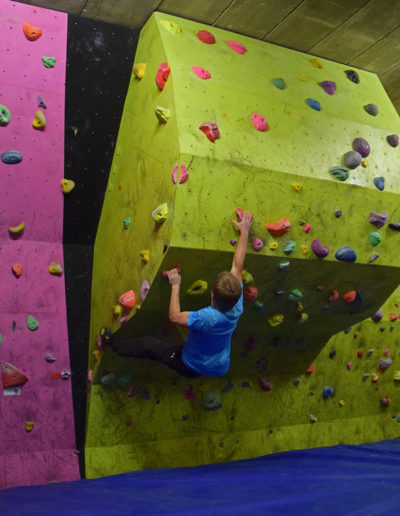Subdisciplines of climbing
Bouldering
Indoor bouldering walls are generally at most 5 m of height. Thick mattresses cover the floor in case of falls. Wall profiles range from slightly inclined to steep overhang or roof. Plastic holds have been mounted on the walls to create routes. Difficulty of the routes range from really easy to extremely difficult, so that climbers of all experience levels have suitable challenges. Bouldering is perhaps the easiest subdiscipline of climbing to start with, since one needs only climbing shoes as an equipment.
Bouldering is at its best outdoors, where it is practiced on low cliffs and boulders. They will be ascended along the holds and formations created by nature over time. Climbers will carry crashpads with them to safeguard falls.
Lead and toprope climbing
Rope attached to harness is used for protection on higher climbing routes where groundfall becomes dangerous. The rope runs from the climber’s harness via an anchor or protection point(s) to the belayer’s harness. The system will stop the fall in case the climber slips off the rock. Climbing with rope requires more knowledge of the equipment and belay techniques than bouldering, and takes some time to master. Climbing itself is similar to bouldering, but requires more endurance. The height of cliffs in Finland range from 8-50 m, with 15 m being typical height.
In toprope climbing the anchor point is at the top of the route so that rope runs always upwards form the climber’s harness. Toproping is a good way to practice longer climbing routes very safely, as the climber will drop only tens of centimeters.
On traditional climbing – or trad for short – the climber sets protection points (steel nuts or spring-loaded camming devices) on cracks as he ascends.
Toprope climbing and sport climbing can be practiced indoors, for example in Tampere, Turku and Helsinki. At present, there is no public indoor wall for toprope or sport climbing in Pori.
Ice climbing
During wintertime, frozen waterfalls can be climbed, with the aid of ice axes and crampons attached to stiff boots. Low walls can be toproped. When lead climbing on ice, ice screws are used as the protection points.
Mountaineering
In mountaineering the goal is to reach the summit. On the easiest level, mountaineering can be scrambling up a steep snow slope, but usually mountaineers use techiques of rock, trad and ice climbing. Unpredictability of weather, and snow and ice conditions, make mountaineering often mentally more challenging and more dangerous than other disciplines of climbing.
climbingclubpori@gmail.com






